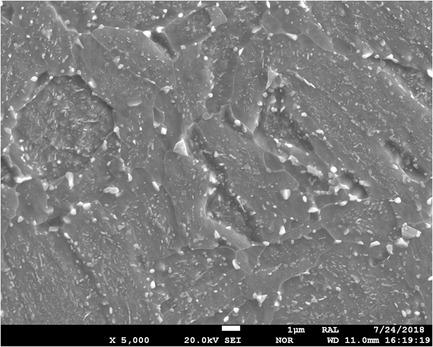当前位置:
X-MOL 学术
›
Steel Res. Int.
›
论文详情
Our official English website, www.x-mol.net, welcomes your feedback! (Note: you will need to create a separate account there.)
Effect of Preheat Treatment on Microstructure and Properties of a Gear Steel for High‐Temperature Carburizing
Steel Research International ( IF 2.2 ) Pub Date : 2020-06-09 , DOI: 10.1002/srin.202000180 Xiaoxue An 1 , Yong Tian 1 , Haojie Wang 1 , Zhaodong Wang 1
Steel Research International ( IF 2.2 ) Pub Date : 2020-06-09 , DOI: 10.1002/srin.202000180 Xiaoxue An 1 , Yong Tian 1 , Haojie Wang 1 , Zhaodong Wang 1
Affiliation

|
Preheat treatment affects not only the microstructure and machinability of the gear steels, but also the final distortion after carburizing and quenching. The effects of preheat treatments of normalizing, tempering, isothermal normalizing, normalizing and tempering, and quenching and tempering on the microstructure and properties of the Nb–Ti microalloyed 18CrNiMo7‐6 gear steel for high‐temperature carburizing are systematically studied herein. The results show that preheat treatment has a significant influence on microstructure evolution, austenite grain coarsening behavior during pseudocarburizing, hardness distribution, and impact toughness of the experimental steel. The microstructure of experimental steel after quenching and tempering is typical tempered martensite with a large number of fine Cr‐rich carbides and Nb–Ti precipitates uniformly distributed. Compared with the pretreatments of simple normalizing, tempering, isothermal normalizing, and normalizing and tempering, the steel after quenching and tempering exhibits the best microstructure uniformity, austenite grain coarsening resistance, machinability, and impact toughness. For the Nb–Ti microalloyed 18CrNiMo7‐6 gear steel, quenching and tempering is the optimum preheat treatment prior to carburizing. In addition, the tempering temperature is selected in the range of 600–650 °C due to the effect of secondary hardening and phase transformation behavior.
中文翻译:

预热处理对高温渗碳齿轮钢组织和性能的影响
预热处理不仅会影响齿轮钢的组织和可加工性,还会影响渗碳和淬火后的最终变形。本文系统地研究了正火,回火,等温正火,正火和回火以及淬火和回火的预热处理对用于高温渗碳的Nb-Ti微合金化18CrNiMo7-6齿轮钢的组织和性能的影响。结果表明,预热处理对实验钢的组织演变,假渗碳过程中奥氏体晶粒粗化行为,硬度分布和冲击韧性具有显着影响。淬火和回火后的实验钢的显微组织是典型的回火马氏体,其中含有大量细小的富Cr碳化物,并且Nb-Ti沉淀物均匀分布。与简单的正火,回火,等温正火,正火和回火的预处理相比,淬火和回火后的钢具有最佳的组织均匀性,奥氏体晶粒粗化性,可加工性和冲击韧性。对于Nb-Ti微合金化18CrNiMo7-6齿轮钢,淬火和回火是渗碳前的最佳预热处理。此外,由于二次硬化和相变行为的影响,回火温度选择在600–650°C的范围内。经过正火和回火,淬火和回火后的钢表现出最佳的组织均匀性,奥氏体晶粒粗化性,可加工性和冲击韧性。对于Nb-Ti微合金化18CrNiMo7-6齿轮钢,淬火和回火是渗碳前的最佳预热处理。此外,由于二次硬化和相变行为的影响,回火温度选择在600–650°C的范围内。经过正火和回火后,淬火和回火后的钢表现出最佳的组织均匀性,奥氏体晶粒粗化性,可加工性和冲击韧性。对于Nb-Ti微合金化18CrNiMo7-6齿轮钢,淬火和回火是渗碳前的最佳预热处理。此外,由于二次硬化和相变行为的影响,回火温度选择在600–650°C的范围内。
更新日期:2020-06-09
中文翻译:

预热处理对高温渗碳齿轮钢组织和性能的影响
预热处理不仅会影响齿轮钢的组织和可加工性,还会影响渗碳和淬火后的最终变形。本文系统地研究了正火,回火,等温正火,正火和回火以及淬火和回火的预热处理对用于高温渗碳的Nb-Ti微合金化18CrNiMo7-6齿轮钢的组织和性能的影响。结果表明,预热处理对实验钢的组织演变,假渗碳过程中奥氏体晶粒粗化行为,硬度分布和冲击韧性具有显着影响。淬火和回火后的实验钢的显微组织是典型的回火马氏体,其中含有大量细小的富Cr碳化物,并且Nb-Ti沉淀物均匀分布。与简单的正火,回火,等温正火,正火和回火的预处理相比,淬火和回火后的钢具有最佳的组织均匀性,奥氏体晶粒粗化性,可加工性和冲击韧性。对于Nb-Ti微合金化18CrNiMo7-6齿轮钢,淬火和回火是渗碳前的最佳预热处理。此外,由于二次硬化和相变行为的影响,回火温度选择在600–650°C的范围内。经过正火和回火,淬火和回火后的钢表现出最佳的组织均匀性,奥氏体晶粒粗化性,可加工性和冲击韧性。对于Nb-Ti微合金化18CrNiMo7-6齿轮钢,淬火和回火是渗碳前的最佳预热处理。此外,由于二次硬化和相变行为的影响,回火温度选择在600–650°C的范围内。经过正火和回火后,淬火和回火后的钢表现出最佳的组织均匀性,奥氏体晶粒粗化性,可加工性和冲击韧性。对于Nb-Ti微合金化18CrNiMo7-6齿轮钢,淬火和回火是渗碳前的最佳预热处理。此外,由于二次硬化和相变行为的影响,回火温度选择在600–650°C的范围内。



























 京公网安备 11010802027423号
京公网安备 11010802027423号